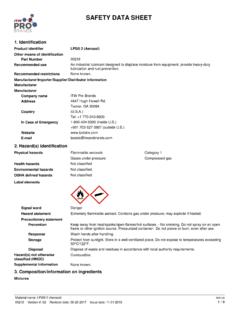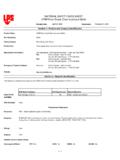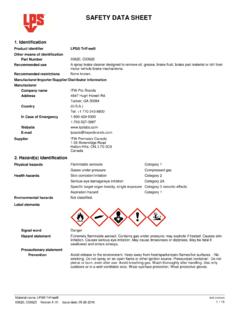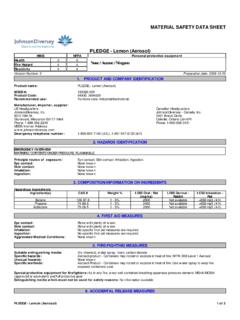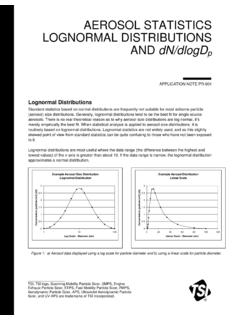Transcription of SAFETY DATA SHEET - LPS Labs
1 SAFETY data SHEET . 1. Identification Product identifier LPS 1 ( aerosol ). Other means of identification Part Number 00116. Recommended use An industrial lubricant designed to displace moisture from mechanical and electrical equipment, provide light-duty lubrication and short-term rust prevention. Recommended restrictions None known. Manufacturer/Importer/Supplier/Distribut or information Manufacturer Manufacturer Company name ITW Pro Brands Address 4647 Hugh Howell Rd. Tucker, GA 30084. Country ( ). Tel: +1 770-243-8800. In Case of Emergency 1-800-424-9300 (inside ). +001 703-527-3887 (outside ). Website E-mail 2. Hazard(s) identification Physical hazards Flammable aerosols Category 1. Gases under pressure Compressed gas Health hazards Not classified.
2 Environmental hazards Not classified. OSHA defined hazards Not classified. Label elements Signal word Danger Hazard statement Extremely flammable aerosol . Contains gas under pressure; may explode if heated. Precautionary statement Prevention Keep away from heat/sparks/open flames/hot surfaces. - No smoking. Do not spray on an open flame or other ignition source. Pressurized container: Do not pierce or burn, even after use. Response Wash hands after handling. Storage Protect from sunlight. Store in a well-ventilated place. Do not expose to temperatures exceeding 50 C/122 F. Disposal Dispose of waste and residues in accordance with local authority requirements. Hazard(s) not otherwise Combustible. classified (HNOC). Supplemental information Repeated exposure may cause skin dryness or cracking.
3 3. Composition/information on ingredients Mixtures Material name: LPS 1 ( aerosol ) SDS US. 00116 Version #: 03 Revision date: 09-19-2017 Issue date: 11-01-2016 1/8. Chemical name Common name and synonyms CAS number %. Distillates Petroleum Hydrotreated 64742-47-8 70 - 80. Light Distillates Petroleum Hydrotreated 64742-46-7 10 - 20. Med Carbon Dioxide 124-38-9 1-5. Sorbitan trioleate 26266-58-0 1-3. Calcium Sulfonate 61789-86-4 - 1. 4. First-aid measures Inhalation Move to fresh air. Call a physician if symptoms develop or persist. Skin contact No adverse effects due to skin contact are expected. Eye contact No specific first aid measures noted. Ingestion Not likely, due to the form of the product. Most important Direct contact with eyes may cause temporary irritation.
4 Symptoms/effects, acute and delayed Indication of immediate Provide general supportive measures and treat symptomatically. medical attention and special treatment needed General information Ensure that medical personnel are aware of the material(s) involved, and take precautions to protect themselves. 5. Fire-fighting measures Suitable extinguishing media Water fog. Alcohol resistant foam. Dry chemical powder. Dry chemicals. Carbon dioxide (CO2). Unsuitable extinguishing Do not use water jet as an extinguisher, as this will spread the fire. media Specific hazards arising from Contents under pressure. Pressurized container may explode when exposed to heat or flame. the chemical During fire, gases hazardous to health may be formed.
5 Special protective equipment Firefighters must use standard protective equipment including flame retardant coat, helmet with and precautions for firefighters face shield, gloves, rubber boots, and in enclosed spaces, SCBA. Fire fighting In case of fire: Stop leak if safe to do so. Do not move cargo or vehicle if cargo has been exposed equipment/instructions to heat. Move containers from fire area if you can do so without risk. Cool containers exposed to heat with water spray and remove container, if no risk is involved. Containers should be cooled with water to prevent vapor pressure build up. For massive fire in cargo area, use unmanned hose holder or monitor nozzles, if possible. If not, withdraw and let fire burn out. Specific methods Use standard firefighting procedures and consider the hazards of other involved materials.
6 Move containers from fire area if you can do so without risk. In the event of fire and/or explosion do not breathe fumes. General fire hazards Extremely flammable aerosol . Contents under pressure. Pressurized container may explode when exposed to heat or flame. Combustible. 6. Accidental release measures Personal precautions, Keep unnecessary personnel away. Keep people away from and upwind of spill/leak. Keep out of protective equipment and low areas. Many gases are heavier than air and will spread along ground and collect in low or emergency procedures confined areas (sewers, basements, tanks). Wear appropriate protective equipment and clothing during clean-up. Emergency personnel need self-contained breathing equipment. Do not touch damaged containers or spilled material unless wearing appropriate protective clothing.
7 Ventilate closed spaces before entering them. Local authorities should be advised if significant spillages cannot be contained. Use personal protection recommended in Section 8 of the SDS. Methods and materials for Refer to attached SAFETY data sheets and/or instructions for use. Stop leak if you can do so without containment and cleaning up risk. Use water spray to reduce vapors or divert vapor cloud drift. Isolate area until gas has dispersed. Eliminate all ignition sources (no smoking, flares, sparks, or flames in immediate area). Keep combustibles (wood, paper, oil, etc.) away from spilled material. For waste disposal, see section 13 of the SDS. Environmental precautions Avoid discharge into drains, water courses or onto the ground.
8 Material name: LPS 1 ( aerosol ) SDS US. 00116 Version #: 03 Revision date: 09-19-2017 Issue date: 11-01-2016 2/8. 7. Handling and storage Precautions for safe handling Pressurized container: Do not pierce or burn, even after use. Do not use if spray button is missing or defective. Do not spray on a naked flame or any other incandescent material. Do not smoke while using or until sprayed surface is thoroughly dry. Do not cut, weld, solder, drill, grind, or expose containers to heat, flame, sparks, or other sources of ignition. All equipment used when handling the product must be grounded. Do not re-use empty containers. Avoid prolonged or repeated contact with skin. Avoid prolonged exposure. Use only in well-ventilated areas. Wear appropriate personal protective equipment.
9 Observe good industrial hygiene practices. Conditions for safe storage, Level 1 aerosol . including any incompatibilities Pressurized container. Protect from sunlight and do not expose to temperatures exceeding 50 C/122 F. Do not puncture, incinerate or crush. Do not handle or store near an open flame, heat or other sources of ignition. This material can accumulate static charge which may cause spark and become an ignition source. Store in a well-ventilated place. Stored containers should be periodically checked for general condition and leakage. Store away from incompatible materials (see Section 10 of the SDS). 8. Exposure controls/personal protection Occupational exposure limits The following constituents are the only constituents of the product which have a PEL, TLV or other recommended exposure limit.
10 At this time, the other constituents have no known exposure limits. - OSHA. Components Type Value Form Distillates Petroleum PEL 5 mg/m3 Oil mist Hydrotreated Light (CAS. 64742-47-8). US. OSHA Table Z-1 Limits for Air Contaminants (29 CFR ). Components Type Value Carbon Dioxide (CAS PEL 9000 mg/m3. 124-38-9). 5000 ppm ACGIH. Components Type Value Form Distillates Petroleum TWA 5 mg/m3 Oil mist Hydrotreated Light (CAS. 64742-47-8). US. ACGIH Threshold Limit Values Components Type Value Carbon Dioxide (CAS STEL 30000 ppm 124-38-9). TWA 5000 ppm US. NIOSH: Pocket Guide to Chemical Hazards Components Type Value Carbon Dioxide (CAS STEL 54000 mg/m3. 124-38-9). 30000 ppm TWA 9000 mg/m3. 5000 ppm Biological limit values No biological exposure limits noted for the ingredient(s).
